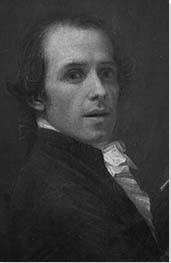Summary of Antonio Canova
Antonio Canova was the most famous and sought-after artist in Europe during his lifetime. Although he came from humble beginnings near Venice, his talent soon propelled him to Rome, where he drew inspiration from Classical Greek and Roman art, Italian Renaissance painting, and the careful study of human form to become one of the leaders of the emerging Neoclassical style, alongside Jacques-Louis David. His sculptures, whether of mythological figures or illustrious contemporaries, quickly became iconic images, and his busy workshop was a must-see sight in Rome. As a favorite artist of popes, emperors, kings, and noblemen, Canova also served in a diplomatic role, particularly after the fall of Napoleon, thanks to his connections across Europe. His graceful compositions and ability to carve and finish marble to resemble mobile, living flesh established his reputation as an artist of both heroic and exquisitely beautiful works.
Accomplishments
- Canova believed that mythological subjects and the idealized proportions and balanced forms of Classical sculpture were the highest forms of art to which an artist could aspire. Like other artists, he absorbed these ideas in part from the influential German art critic Johann Joachim Winkelmann, who had earlier written that Greek art displayed "a noble simplicity and calm grandeur in gesture and expression."
- Canova's Neoclassical style helped to suggest a visual and ideological connection to what contemporaries believed were the ideals of Classical antiquity, which made his work popular with rulers and aristocrats across Europe who wished to bolster their own claims to power and prestige; the renown that resulted from his popularity also allowed Canova to work diplomatically for a wide range of different and sometimes opposed patrons.
- Canova was highly skilled at carving and finishing marble, and although he ran a busy workshop of assistants, he insisted on finishing every one of his works himself. His balanced, graceful forms, treatment of nude or lightly draped bodies, and smooth, finely polished, and sometimes tinted or waxed surfaces, produced sculptures that had lifelike presences.
- In his effort to create "modern classic" works, Canova combined his knowledge of Greek and Roman antiquities with careful study of the human figure and synthesized these components through the process of sketching and modeling to develop highly original, imaginative compositions.
The Life of Antonio Canova
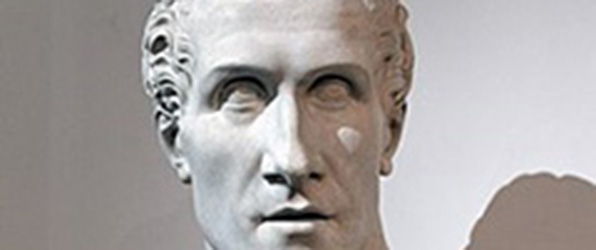
Canova was so skilled at producing beautiful, appealing sculptures that his work provoked reactions like those of French author Gustave Flaubert, who wrote, after seeing Cupid and Psyche, "I kissed the armpit of the swooning woman who stretches her long marble arms toward Cupid... And then the foot! The head! Her face! ... Indeed it was something more; I was kissing beauty itself."
Important Art by Antonio Canova
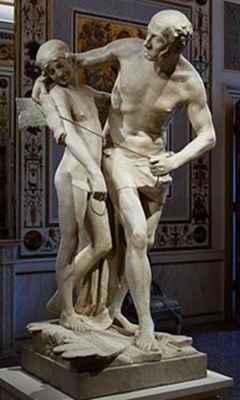
Daedalus and Icarus
In this early work, Canova drew from a story in Greek mythology, retold by the Greek poet Ovid in Metamorphoses, to depict the architect and inventor Daedalus and his son, Icarus. According to the story, Daedalus created the Labyrinth to contain King Minos of Crete's stepson, the Minotaur, who was half man and half bull. But after Daedalus helped the warrior Theseus slay the Minotaur, King Minos trapped Daedalus and his son in the maze. To escape, Daedalus crafted wings made of wax and feathers, and the two successfully flew off the island. Unfortunately, Icarus became too confident in his skill and, despite his father's warning, flew too close to the sun, melting the wings and causing him to crash into the sea and drown.
Canova depicted Daedalus in the process of affixing wings to his son's shoulders. In the manner of Classical sculptures, the figures are shown partially or fully nude, but Canova gave his figures more detailed realism and pronounced expressions than Classical works. Daedalus's thinning hair and furrowed brow emphasize his age, while his tight-lipped expression reveals his concentration on the task, as well as concern for his son's welfare. In contrast, Icarus is a slender adolescent, smiling and leaning back lightly into his father's protective embrace. Compositionally, the work also employs an approach Canova would often return to, in which the figure's limbs form an interlaced shape that encloses a dynamic negative space. The work was praised for its originality and naturalism when it was shown at the Fiera della Sensa (Ascension Fair) exhibition in Venice in 1779, and it also earned him the commission for one of his next major works, Theseus and the Minotaur.
Marble - Museo Correr, Venice
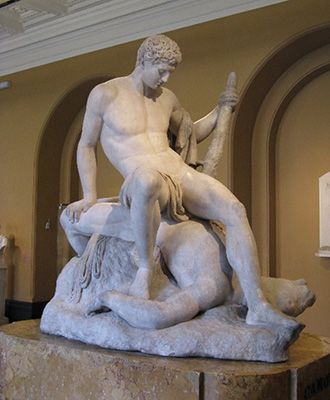
Theseus and the Minotaur
For the first major commission made in his newly established Roman studio, Canova again turned to Ovid's Metamorphoses and Greek mythology, depicting the hero Theseus after his battle with the Minotaur. According to the tale, Queen Pasiphae of Crete had been made to fall in love with a bull, and the result was the monstrous Minotaur, who had the body of a man and the head of a bull. Sent as one of the humans who were regularly sacrificed to feed the Minotaur, Theseus instead killed the monster, and found his way back out of the labyrinth in which he had been held with the help of Ariadne, Pasiphae's daughter. The thread Ariadne gave Theseus to help him escape is visible here, coiled under the Minotaur's leg.
Canova's initial idea had been to choose a dramatic moment with the figures in active conflict, as often seen in Classical Greek vase painting of this subject. However, on the advice of Gavin Hamilton, a Scottish artist and archaeologist living in Rome who had seen Canova's expressive Daedalus and Icarus, he chose instead to depict the aftermath of the struggle. By showing Theseus contemplating the fate of the monster who might have killed him had he not conquered it, Canova embodied the concepts of calm and restraint that were considered key principles of antiquity and came to characterize Neoclassical art of the period, particularly in contrast to the energetic and dramatic style of Baroque art that had preceded it. The figures' interlocking arms and legs, and the complementary curves of their torsos and inclined or thrown-back heads are also typical of the sculptor's balanced and graceful style.
The work was commissioned in 1781 by Girolamo Zulian, the Venetian ambassador in Rome, who gave the massive block of marble (one of the largest in the Victoria and Albert's collection) to the artist and let him choose the subject. The support of this influential patron and the critical success of the resulting work established Canova as one of the leading artists in Rome of the time.
Marble - Victoria and Albert Museum, London
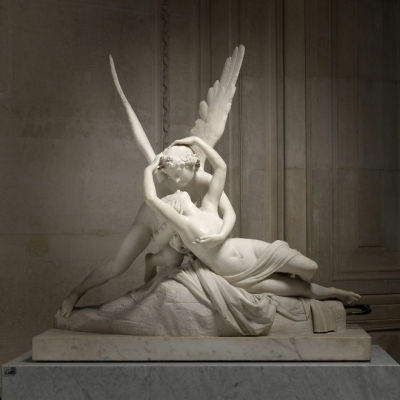
Psyche Revived by Cupid's Kiss
Having made independent depictions of the mythological figures Cupid and Psyche, Canova devised this pair in response to the commission of Colonel John Campbell, a Scottish collector who visited the artist in Rome in 1787. The narrative, as Canova noted in a letter, was drawn from The Golden Ass, a 2nd century AD text by Lucius Apuleius, who recounts the story of the beautiful mortal Psyche and the god Cupid, son of Venus, who fell in love with her. Angered, Venus put Psyche through a series of ordeals, the last of which was to retrieve a flask from the Underworld but not to open it. When she could not resist opening the container, Psyche was overcome by deadly fumes, but was revived from near-death by Cupid's touch. This is the moment Canova depicted, as Cupid raises his love from the ground and she returns to life in his embrace.
Canova spent considerable effort on the complex composition of this work, making numerous drawings and clay and plaster models. He seems to have been inspired in part by an image found in the ancient city of Herculaneum, whose rediscovery and excavation (along with Pompeii) a few decades earlier catalyzed the Neoclassical movement across Europe. The image, reproduced in an engraving published in 1757, shows a faun and a bacchante embracing, in poses echoed by Canova's couple. But the sculptor refined and idealized such source material, giving his figures the slim forms and serene features of the Classical sculptures he was emulating. The pair's entwined and counterbalanced arms, legs, and wings create a dynamic composition that spirals upward and that cannot be fully appreciated from a single vantage point; indeed, the sculpture was initially installed on a base that could be turned so the work could be seen from different angles. The varied physical qualities and surface textures Canova created, from soft skin to filmy drapery to Cupid's powerful yet partially translucent wings, are testament to his remarkable skill at handling marble.
The original patron of this work, Colonel Campbell, could not pay for it, but it was soon acquired by Joachim Murat, Napoleon's brother-in-law, and installed at his estate near Paris where it was widely admired. The Russian Prince Nicholas Youssoupov also saw this work and requested a second version (now in the Hermitage, Saint Petersburg), in which Psyche's legs are more fully draped. The exquisite grace and beauty of this work set the standard for Canova's refined and elegant style, a part of his output that at times overshadowed his depictions of heroic figures and monuments to significant people.
Marble - Musée du Louvre, Paris
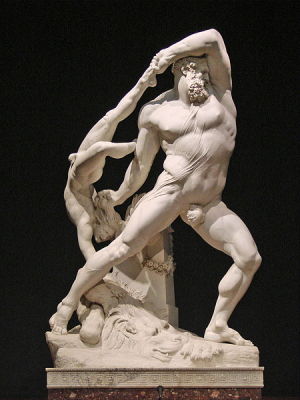
Hercules and Lichas
Like many of Canova's major works, this sculpture developed over a long period of time, in part thanks to its colossal size - it stands nearly eleven feet tall - and in part due to the turbulent times in which it was made. The Neapolitan nobleman Onorato Gaetani commissioned the work from the sculptor and proposed the subject, drawn from Greek mythology and literature. As Sophocles' play The Women of Trachis recounts, the wife of the hero Hercules sent his herald Lichas to give him a cloak which she had dipped in a magical fluid, hoping it would cause her husband to remain faithful to her. Instead, it poisoned him, and driven to madness by pain and anger, he flung Lichas into the sea. In Canova's interpretation, the deadly cloak appears as a thin, filmy garment draped across Hercules's chest, while the lion skin he usually wore lies at his feet. The patron had promised Canova a large sum for this work, of which he had produced a large-scale model by the following year, but when the French army invaded Naples, Gaetani was forced into exile and could no longer accept the sculpture. After leaving Rome himself and then struggling to find another buyer, Canova finally completed the work in 1815 for a Roman banker.
In depicting the height of the story's dramatic action, Canova combined a moment of extreme effort and terror with the almost balletic grace of his figures' innovative poses. Hercules, a demi-god renowned for his strength, is shown at a larger scale than the mortal messenger Lichas, his powerful body straining in a backward arc as he prepares to hurl the innocent servant. Both figures are grimacing open-mouthed in their terror and anguish. In working through numerous compositional possibilities in his drawings, Canova settled on a configuration that is self-contained and harmoniously balanced, but also filled with immanent, explosive motion. The contrasts of beautiful and terrifying captured in this work embody the concept of the sublime, an idea that artists and writers had already begun to explore in the late eighteenth century and would continue to express in the Romantic movement of the following years. As scholar Christopher M. S. Johns has noted, this work exemplifies Canova's achievement, as he based his work on classical models updated with naturalistically described figures, combined in inventively original compositions.
Marble - Galleria Nazionale d'Arte Moderna, Rome
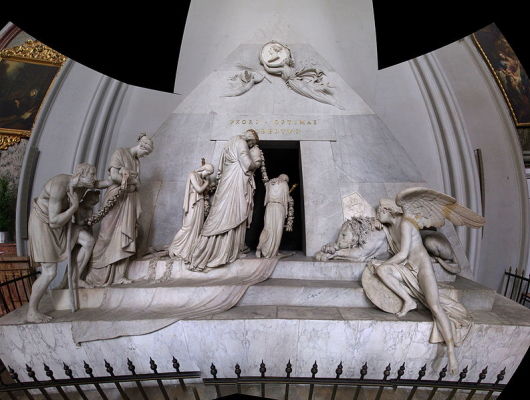
Monument to Archduchess Maria Christina of Austria
In 1798, when Canova was traveling in Austria after leaving behind his Roman studio, Duke Albert of Saxony-Teschen commissioned the sculptor to create a memorial in the Church of Saint Augustine in Vienna for his wife, Archduchess Maria Christina of Austria, who had just died. Canova decided to base the monument on a design he had earlier developed as a memorial to the artist Titian but had never completed. The work consists of a large pyramid inspired by the ancient Roman Pyramid of Caius Cestius, into which a line of mourners enters through a dark, open doorway. In the center, a woman carries the Archduchess's urn, accompanied by two children, at the left another woman helps an old man up the steps, and at the right, a melancholy angel leans on a sleeping lion, the symbol of the Hapsburg family to which Maria Christina belonged.
Canova's design was startlingly innovative in combining an ancient architectural form with more modern imagery, and in representing Maria Christina herself only in a small portrait medallion over the pyramid's door. This contrasts with traditional funerary monuments, such as Michelangelo's tombs of the Medici in Florence, which center on full-length sculptures personifying the deceased. Instead, the subject of Canova's memorial is death itself, embodied in the universal idea of the dark and unknowable space beyond the open door, a threshold people of all ages may cross. The groundbreaking nature of this conception was recognized by one of Canova's earliest patrons, Girolamo Zulian, who commented on a model of the Monument to Titian that "your idea appeals to me immensely, by virtue of its innovative qualities, simplicity, and expression."
Marble - Church of Saint Augustine, Vienna
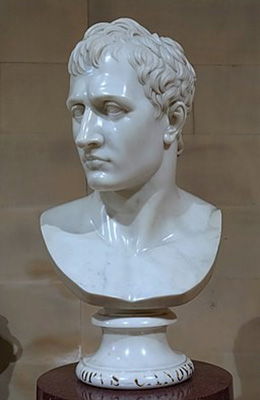
Colossal Head of Napoleon Bonaparte
Canova did not often make straightforward portraits, as he felt the genre required the artist merely to imitate nature rather than to create a work of his own imagination. Nonetheless, despite his distaste for the military commander who had overthrown the Venetian Republic and stolen masterpieces of Italian art, Canova could not turn down the commission from Napoleon when he was still First Consul of France, near the height of his meteoric rise to leader of the country. When Canova arrived in Paris in October 1802, he had several sittings with Napoleon, resulting in a bust-length clay model for a work that he intended to incorporate into a monumental depiction of the leader in the mythological guise of Mars, the Greek god of war, as a peacemaker. Although the clay original is now lost, there are two plaster versions that Canova probably made from the model, both showing the sitter wearing a high-collared jacket. In order to portray Napoleon as a heroic Greek god, however, the artist insisted that he appear nude, as subsequent marble versions of the bust indicate. This version, measuring over two feet high, was probably executed entirely by Canova, and is said to have remained in his possession until his death. Indeed, this portrayal of Napoleon became so popular that over forty copies of the bust were made during Canova's lifetime, many of them without the artist's involvement.
With its tousled hair and resolute, brooding expression, this portrait captures a sense of both the real and the legendary Napoleon, both the conquering warrior and the self-made Romantic hero, as scholar Fred Licht noted. The full-length monumental sculpture was rejected by Napoleon when it was delivered to him in 1810, not only because he disliked the work's nudity (not to mention its overly idealized, tall, athletic figure), but also because, in a changed political climate, he could no longer accept the complex implications of appearing as a god-like hero. Canova's bust, however, was simpler and more evocative, and it became one of the iconic, official images of the Emperor.
Marble - Devonshire Collections, Chatsworth
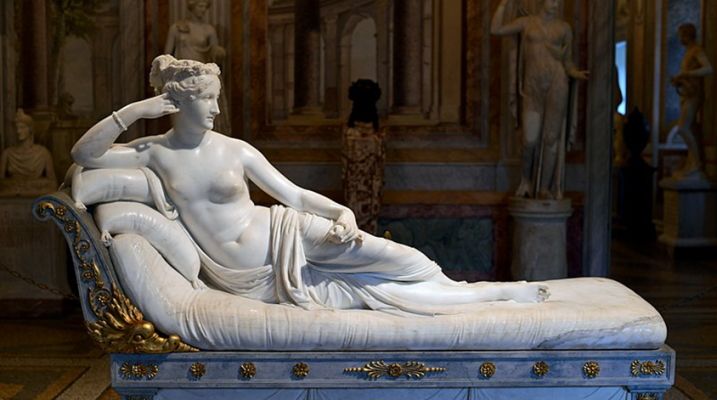
Pauline Bonaparte as Venus Victorious
This semi-nude sculpture depicts Pauline Bonaparte Borghese as Venus, the Greek goddess of love, beauty, and fertility. She holds an apple in her left hand, a small narrative element that links this depiction to the mythological tale of the Judgment of Paris, in which Trojan prince Paris found Venus to be the most beautiful of three goddesses, rather than Minerva or Juno. He then gave her a golden apple to indicate her victory.
Pauline was the sister of Napoleon Bonaparte, who had, in 1803, helped engineer her marriage to the Roman nobleman Camillo Borghese, a member of the prominent Italian family, with hopes that it would help consolidate French power over the newly conquered regions of Italy. The couple commissioned a portrait from Canova the following year. Canova initially proposed depicting Borghese in the guise of the virginal Diana, goddess of the moon and hunting, but Borghese, well known for her extramarital affairs and proud of her own powers of attraction, insisted on appearing as Venus. While the artist might have been reluctant to highlight the sitter's physical charms quite so openly, his portrayal, as scholar Fred Licht has suggested, implies that Borghese has taken on the attributes of the goddess thanks only to her social position and her self-regard - qualities she was happy to acknowledge - rather than her moral virtue or historical significance.
The subject of Venus Victorious appears very rarely in Classical sculpture; instead, Canova's composition clearly echoes Italian Renaissance paintings such as Titian's Venus of Urbino, which similarly shows the nude figure reclining on a bed. The composition also emphasizes the negative space toward which Borghese gazes confidently, allowing the viewer to imagine him or herself filling that space alongside the alluring figure. This sense of being in the presence of the sitter is enhanced by Canova's innovative use of a carved and gilded marble bed rather than a neutral pedestal, further blurring the line between the illusionistically sculpted work and the real space around it. Given its intimate and potentially scandalous nature, the sculpture was kept (and remains) in Borghese's private residence, where only selected guests were invited to view it by candlelight, further heightening its allure.
Marble - Galleria Borghese, Rome
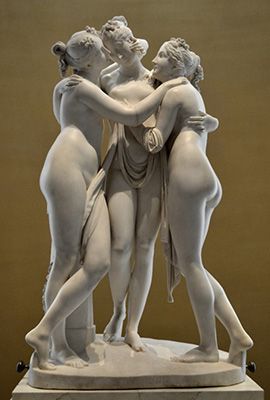
The Three Graces
According to Greek myth, the three Graces were the daughters of Zeus and a sea nymph. Their names (viewing the sculpture from left to right, as Canova identified them) were Euphrosyne, Aglaia, and Thalia. Rather than conveying a narrative, the sisters have been depicted since antiquity to embody numerous positive attributes such as youth, beauty, sensuality, and love, and collectively as representing friendship, affection, or kindness. Canova was probably familiar with at least one Roman sculptural group as well as numerous Renaissance paintings depicting the Graces; in his interpretation, however, the central figure is facing forward rather than back, as in the Classical prototypes, and the figures stand in a closer, more intimate embrace, emphasizing the sensual quality of the group. This quality is underscored by the figures' own light touch on each other's waist or shoulders, as well as the glowing, smoothly finished surface, demonstrating Canova's consummate skill at creating "that look of living softness given to the surface of the marble, which appears as if it would yield to the touch," as one writer described it.
While Canova had made an earlier painting of the Three Graces, the idea for this sculpture came initially in 1812 from Josephine de Beauharnais, first wife of Napoleon Bonaparte; she was already an enthusiastic patron of the sculptor (the first version is now in the State Hermitage Museum in Russia). In 1814, upon seeing the work in progress in the artist's studio, the Englishman John Russell, 6th Duke of Bedford, asked Canova to make a second version, remarking, "I frankly declare that I have seen nothing in ancient or modern sculpture that has given me more pleasure." As he usually did, Canova made certain modifications to the work - most noticeably changing a square pedestal behind the figures in the first version into a rounded column in the present work - and considered the second version to be an improvement. Russell was so excited to acquire the sculpture that he persuaded Canova to visit his estate outside London when the artist was visiting the city in 1815, and then followed Canova's advice about placement and lighting to construct a rotunda specifically for the work, which he named the Temple of the Graces.
As with most of Canova's work, the Three Graces was widely acclaimed; the Italian poet Ugo Foscolo dedicated one of his most famous poems, "The Graces," to the artist before the sculpture was even finished, and the French author Stendhal, who visited Canova's studio, commented that each new work of his was an event in Rome, and a step toward a new type of beauty. It also further reinforced Canova's reputation as the consummate sculptor of beautiful, elegant subjects.
Marble - Victoria and Albert Museum, London, and National Galleries of Scotland, Edinburgh
Biography of Antonio Canova
Childhood
Antonio Canova was born November 1, 1757, in Possagno, Italy, a village within the Venetian Republic, to Pietro Canova, a stonemason, and Angela Zardo. Following Pietro's death in 1761, Angela remarried the following year and young Antonio was raised by Pietro's father, Pasino Canova, who owned a marble quarry and was also a stonemason and sculptor. With this upbringing, Antonio showed potential early on. Although apocryphal, a story is told that the boy attracted attention when he carved a lion's head out of butter at age six or seven while attending a dinner party. His skill seems to have attracted the attention of the Venetian senator and arts patron Giovanni Falier. At Falier's recommendation, Canova was apprenticed to the sculptor Giuseppe Bernardi when he was fourteen years old.
Early Training
Canova spent about two years in Bernardi's bustling Venetian workshop, and after the master's death in 1774, entered the workshop of Bernardi's nephew, Giovanni Ferrari. Through these apprenticeships he strengthened his skill at stone carving by assisting with a variety of commissioned works. He also took life drawing classes at the Venice Academy of Fine Arts, sketching live models to improve his ability to represent the figure, a fundamental skill for a traditional artist. At the same time, Canova frequently visited the extensive collection of aristocratic art collector Filippo Farsetti, where he carefully studied the terracotta models by Baroque masters such as Gian Lorenzo Bernini, along with plaster copies of Classical Greek and Roman sculptures. In return, Canova produced his first independent works, two Baskets of Fruit (1774), for Farsetti, who placed them in the staircase of the palazzo that housed his collection.
In the following few years, Canova's connections among the Venetian elite led to numerous commissions for portraits and mythological figures, including Eurydice and Orpheus, a pair of figures he made for his early supporter Senator Giovanni Falier in 1775-77, and Daedalus and Icarus (1777-79), commissioned by Procurator Pietro Pisani and shown at the Venetian Fiera della Sensa exhibition. Already in these early works, Canova strove to emulate the ideal proportions and forms of Classical sculpture, emphasizing the grace and beauty of the figures and even depicting his portrait subjects in minimal drapery rather than contemporary clothing. The dynamic gestures and dramatic expressions of these figures, however, were also informed by more recent Baroque practice, which tended to favor heightened emotions and movements.
Thanks to his success, Canova was able to undertake a tour of Italy in 1779-80, his primary goal being a visit to Rome, where he could see Classical Greek and Roman sculptures first-hand. In a diary of his travels, he also recorded experiences in Bologna, Florence, and Naples. Canova was welcomed in Rome by the Venetian Ambassador Girolamo Zulian, who became an enthusiastic patron. By 1781, thanks in part to Zulian's support, as well as a three-year stipend from the city of Venice, Canova established a studio in Rome. That same year, Canova received a commission from Zulian that established his place on the European art scene: the epic Theseus and the Minotaur (1781-82), a work that was acclaimed by writers and other artists and is often considered the first major Neoclassical sculpture.
Mature Period
Once settled in Rome, Canova soon earned further commissions, including large-scale funerary monuments for two popes, portraits, religious works, and mythological subjects. In these works, he combined several sources of inspiration - including continued careful study of Classical sculptures, naturalistic drawings of live models, and sixteenth and seventeenth-century paintings - to develop his characteristic style. He was surrounded in Rome by a community of artists from across Europe who similarly revered Classical antiquity and were still fascinated by the recently rediscovered ruins of Pompeii and Herculaneum, but also valued the direct study of nature. Among these were the Scottish painter, archaeologist, and art dealer Gavin Hamilton, a leading figure in the emerging Neoclassical movement who befriended and advised Canova. It was Hamilton who had suggested that Canova represent Theseus in the sculpture Theseus and the Minotaur in a contemplative pose after having killed the beast, rather than in the struggle of battle. The French art and architectural historian and theorist Antoine Quatremère de Quincy was another supporter; he saw the Theseus in Canova's studio in 1783 and became a lifelong friend and correspondent, publishing a monograph on the sculptor in 1836. By 1787, Canova had achieved such acclaim that the architect Pietro Zaguri declared in a speech at the Academy of Fine Arts in Venice that the artist had "in a few years and still in his youth equaled the skill of the most famous Greek sculptors."
Canova's growing fame led patrons from across Europe to seek out his work. One of his best-known sculptures, the reclining Cupid and Psyche (1787-93), was commissioned by Colonel John Campbell, a Scottish collector who met Canova in Rome and Naples in 1787 and went on to request a number of works from him. Campbell was unable to pay for the sculpture when it was completed, so it was subsequently bought by Joachim Murat, a French military commander and brother-in-law of Napoleon, who had it and a second, standing version of Cupid and Psyche (1787-97) installed at his estate outside Paris by 1802, where Napoleon himself saw and admired it.
Canova headed a busy studio with several assistants, which enabled him to work on multiple projects simultaneously, in different stages of completion. While these assistants often roughed out the marble blocks and did some more advanced carving, Canova worked on each sculpture in detail, and insisted on finishing each piece himself. His prolific production and extensive network of patrons solidified his preeminence in the 1790s. In 1792 the second of his papal monuments, dedicated to Clement XIII, was unveiled in Saint Peter's Basilica in Rome, and in 1796 the author Fausto Tadini published the first book on the artist; in the same year, according to art historian Giuseppe Pavanello, the administrator of the basilica of San Marco in Venice dedicated a room in his residence to a collection of Canova's bas-reliefs and plasters and opened it for public viewing. Despite all his success, the unstable political situation in Europe in the period following the French Revolution soon began to affect the sculptor.
French troops, with Napoleon Bonaparte at their head, invaded northern Italy in 1796, defeating Austrian forces who had previously controlled the region and taking over much of the territory by spring 1797. By the fall, the centuries-old Republic of Venice - where Canova had begun his career - was defeated, and control of the region divided between France and Austria. At this time Napoleon himself wrote to Canova to assure him that the stipend he had been receiving from the Venetian government would continue to be paid and that he would receive protection from the military. Nonetheless, after the French army invaded Rome in 1798, removed the pope from power, and set up a Roman Republic, Canova retreated to Possagno, his native village, which was within the Austrian-controlled region. From there, he initially traveled for several months through Austria and Germany, and when he returned to Possagno he worked primarily on making paintings, partly inspired by works by artists such as Peter Paul Rubens which he had seen on his journey.
In 1799 Canova returned to his studio in Rome, where his assistants had remained along with numerous unfinished projects. These included an over-life size group of Hercules and Lichas, first commissioned in 1795 (but not completed until 1815), and a monument for the tomb of Maria Christina of Austria, commissioned in 1798 (completed in 1805). He also continued to be flooded with new commissions. Perhaps most significantly, several of these came from Napoleon and his associates, particularly after Napoleon took over control of France as First Consul in 1799 and consolidated his power further in the following years, crowning himself Emperor in 1804.
In 1802, the reinstated Pope honored Canova with title Knight of the Golden Spur, named him Inspector General of Antiquities and Fine Arts, and installed his Perseus Triumphant (1801) in the Vatican to replace the sculpture of Apollo Belvedere, which Napoleon had seized and transported to Paris along with many other masterworks from Italy. As the most acclaimed artist in Europe, Canova had already attracted the French ruler's attention, and in the autumn of 1802 he traveled to Paris at Napoleon's invitation to create his portrait, despite his misgivings over working for the general who had attacked and pillaged his homeland. He first modeled a bust-length portrait in clay (subsequently making numerous versions and copies), which he then used as the basis for a monumental sculpture of Napoleon as Mars the Peacemaker (completed 1806), but Napoleon ultimately did not accept the work, as he found the figure "too athletic." Also that fall, Napoleon's wife, Josephine de Beauharnais, requested a replica of the standing version of Cupid and Psyche she had viewed at Joachim Murat's estate. Canova, for his part, on seeing these works again, found faults in his carving of the marbles and reworked portions of them on site for several days; he often viewed requests for new versions of his sculptures as an opportunity to improve on his first efforts.
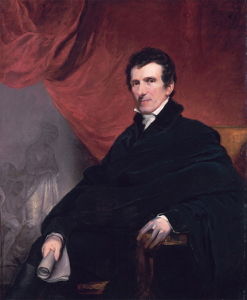
Napoleon and his family recognized the power of the Neoclassical idiom, which Canova so skillfully employed, to create a kind of visual and conceptual lineage to legitimate their power; they also appreciated that the sculptor's wide renown would further burnish their own image. Although Canova rarely created simple portraits, finding them too dependent on naturalistic description rather than imagination, he consented in 1804 to create the portrait of Napoleon's sister, Pauline Bonaparte Borghese, in the guise of Venus Victorious (completed 1808). As with the sculpture of Napoleon, the blending of a mythological Greek god or goddess with the portrait subject granted both the sitter and the work of art a more elevated status. Similarly, Canova's work for Napoleon, whose rise to imperial power over much of Europe gave him an almost mythical aura, further enhanced the artist's fame.
At the same time, part of Canova's role as Inspector General of Antiquities and Fine Arts was to try to retain Italy's artistic treasures in their home country. He also responded more directly to Napoleon's seizure of art in Italy, when, while stopping in Florence on his return from Paris in 1802, the city authorities commissioned him to make a copy of the famed Medici Venus, which Napoleon had taken from the Uffizi Galleries. Ultimately, rather than copy the classical Greek sculpture, Canova made his own version of the standing nude figure, known as the Venus Italica (1803-11), which was widely acclaimed. Several observers found it more appealingly humanized than the remote and idealized Greek sculpture - as the Italian writer and poet Ugo Foscolo commented, "if the Medici Venus is a beautiful goddess, [Canova's Venus Italica] is a beautiful woman."
Canova was summoned to Paris once again in 1810, this time to make a portrait of Napoleon's second wife, Marie Louise, and while there, he also visited the emperor's just-divorced former wife, Josephine, with whom he remained friendly. Two years later, Josephine wrote to Canova to request a new work depicting the Three Graces (1812-17), another of his most celebrated creations. Events soon overtook this commission, however, as Napoleon was defeated by European forces and abdicated as Emperor in April 1814, and Josephine died a month later. Her son Eugène then took over ownership of the Three Graces as it was still in progress. Once Napoleon was definitively defeated at Waterloo in 1815, Europe was reopened for travelers; one English visitor to Canova's studio in Rome, John Russell, Duke of Bedford, requested a second version of the Three Graces (1815-17) which the sculptor worked on alongside the first.
In part thanks to his international profile, Canova was himself drawn into political events in 1815, when he was nominated by Pope Pius VII as ambassador to France and charged with recovering a portion of the hundreds of works of art that had been removed from Italy. After traveling again to Paris, he succeeded after about a month of negotiations. Once the first return shipment of art had been organized, Canova took the opportunity to travel to London in November 1815, where he could visit and thank many of his long-term patrons and supporters and visit collections and museums. Perhaps his primary goal, however, was to see the marble sculptures that Lord Elgin had removed from the Parthenon in Athens and shipped to London just three years earlier. These were among the first original Greek sculptures (rather than later copies) that Canova had been able to see, and in a letter to Quatremère de Quincy, his longtime friend who had been unable to join him on his trip from Paris to London, he expressed his great admiration, describing the sculptures as "real flesh." After Canova returned to Rome in January 1816, the Pope rewarded him for his achievements with the title of Marquis of Ischia and a sum of 3,000 scudi, which the sculptor used in part to set up scholarships for students at the art academy.
Later Years
By 1816, Canova's fame had long been established; indeed, as scholar Iain Gordon Brown noted, his studio in Rome (along with that of his sometime-rival, Bertel Thorvaldsen) was a required sight on the Grand Tour of Europe made by many cultivated, upper-class travelers, in addition to Rome's classical monuments and Renaissance palaces. As well as art connoisseurs and collectors, many prominent writers figured among his enthusiasts, including Honoré de Balzac, Charles Dickens, Heinrich Heine, Henry James, John Keats, and Lord Byron, who noted in 1818 after visiting Rome that "Italy has great names still... Europe - the world - has but one Canova."
Nonetheless, he continued to immerse himself in his work. Among other new commissions, he received his only request from an American patron, from the state of North Carolina, to sculpt a portrait of George Washington (1816-21) (though the original was destroyed in an 1831 fire), and a request from the British government to create a memorial in Saint Peter's Basilica in Rome to commemorate three members of the royal Stuart family who had died in exile in Italy. Another British visitor to his studio, William Cavendish, 6th Duke of Devonshire, commissioned a sculpture from him, Endymion (1819-22), which was among his last completed works. On seeing it, the Duke's wife commented that "it lives, it breathes, it is all life, and youth, and beauty... it is a form so beautiful, of such nature, taste, and loveliness, that I really think it is the most perfect of all his works."
In his last years, despite his declining health, Canova spent much of his time working on the parish church in his birthplace of Possagno. The town had initially asked the artist to contribute to the restoration of the existing church, but given its state of disrepair, Canova soon decided to design a new structure, dedicated to the Holy Trinity, which he envisioned as a model of neoclassical architecture, combining the simple Doric order of the Parthenon with the vaulted dome of the Pantheon. He financed most of the project himself and determined that he would be buried there at his death. In July 1819, the artist symbolically laid the church's cornerstone, although the building was not completed until 1836, after the artist's death.
Canova had worked tirelessly for years and continued to travel to oversee work despite suffering from increasingly poor health. On one of his visits to Possagno in the autumn of 1822, he felt particularly ill, and went to Venice to receive medical care. There, on October 13, 1822, Canova died at the home of a friend. Upon his death, Canova's half-brother and heir, Giovanni Battista Sartori, ensured that he was eventually buried in the church in Possagno, and he subsequently transferred the clay and plaster models, marble sculptures, paintings, drawings, and other items that remained in the artist's Roman studio to the town, where they are now housed in the Museo Antonio Canova.
The European artistic community swiftly mourned Canova. Services in his honor were held in Rome and Venice as well as his hometown of Possagno, and his body treated as if it were a saintly relic. Notably, parts of his body are preserved in Venice: his hand at the Academy of Fine Arts and his heart at Santa Maria Gloriosa dei Frari, in a monument executed by his assistants after a tomb sculpture he himself had designed for the artist Titian.
The Legacy of Antonio Canova
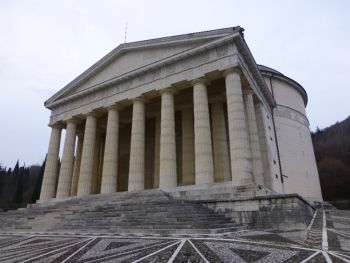
Canova's work helped set the standard for eighteenth-century Neoclassical grace and elegance in sculpture, and his memorable compositions are famous to the present day. His heroically themed works also explored the idea of the sublime, in line with the emerging Romantic movement of the nineteenth century. He was prolific in his production, often creating multiple versions of a sculpture for different patrons. He was widely critically acclaimed during his lifetime, although some writers found his work overly elegant and mannered, particularly in comparison to the Danish sculptor Bertel Thorvaldsen, who worked in Rome in a similar Neoclassical style, but used simpler and more austere forms. After his death, Canova's reputation declined somewhat; this is exemplified by nineteenth century art critic John Ruskin's comment that "the admiration for Canova I hold to be one of the most deadly symptoms in the civilization of the upper classes in the present century." Because his work was so popular, it was often copied by later artists in sculptures of inferior quality, which also harmed his reputation.
Canova had no official students who carried on his legacy, and having devoted his life to his art, he had no direct descendants. He did, however, use his considerable wealth to establish scholarships and other support for young artists and to fund the rebuilding of the church in his hometown, and as a fine arts administrator, he worked to repatriate and preserve Italy's artistic heritage.
Influences and Connections

-
![Titian]() Titian
Titian -
![Gian Lorenzo Bernini]() Gian Lorenzo Bernini
Gian Lorenzo Bernini - Johann Joachim Winkelmann
- Giuseppe Bernardi (Torretti)
- Gavin Hamilton
- John Flaxman
- Bertel Thorvaldsen
- Fabrizio Plessi
- Giuseppe Bernardi (Torretti)
- Gavin Hamilton
- John Flaxman
Useful Resources on Antonio Canova
- CanovaOur PickBy Fred Licht and David Finn
- Antonio Canova and the Politics of Patronage in Revolutionary and Napoleonic EuropeBy Christopher M. S. Johns
- Memoirs of Antonio Canova: With a Critical Analysis of His Works, and an Historical View of Modern SculptureBy John Smythe Memes
